

Deep Litter Method for Rabbits. Mathurine in her deceptively empty cage.

She has just demolished a pound of wild greens and the remnants have been folded into the bedding Lately I’ve been trying something new in my rabbitry, the deep litter method. DIY Sprouted Fodder for Livestock - The Happy Homesteader. Sprouting and growing grain for livestock fodder is a simple and efficient way to not only feed your animals a more natural and fresh diet, but is also a practically effortless way to save money.
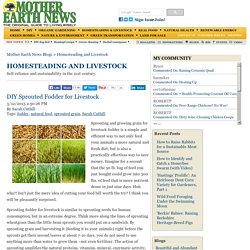
Imagine for a second that the 50 lb. bag of feed you just bought could grow into 300 lbs. of feed that is more nutrient dense in just nine days. Huh wha?! Isn’t just the mere idea of cutting your feed bill worth the try? Breeding New Zealand White Rabbits. The Rabbit Doe is polyestrus (having no regular estrus cycle).
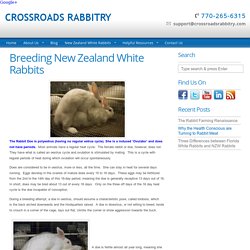
She is a induced ‘Ovulator’ and does not have periods. Most animals have a regular heat cycle. The female rabbit or doe, however, does not. Welsh Harlequin Ducks. Few duck breeds possess as many exceptional qualities as the Welsh Harlequin for the small farmstead.
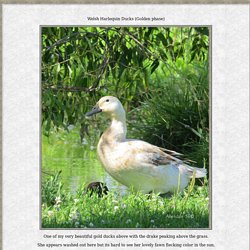
They are a lightweight, non-flying (and non-migratory) duck that produces an average of 280-330 eggs a year, easily out-doing many dual-purpose chicken breeds. Unlike most ducks and chickens that lay well, Harlequin hens still have relatively strong mothering instincts and, if allowed, will naturally incubate and raise a clutch of ducklings, especially when they are three years or older. Beginners Guide to Keeping Ducks. Keeping a few domestic ducks in the garden is a growing trend and having kept them myself for a few years, I can understand why people are drawn to keeping a few of these webbed wonders.
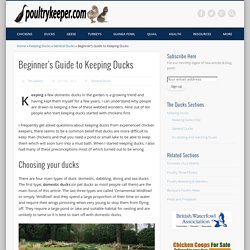
Nine out of ten people who start keeping ducks started with chickens first. Welsh Harlequin Ducks. Raising Ducks by Dave Holderread from the October/November, 2007 issue of Backyard Poultry. Free Range Chickens: The Good, the Bad, and the Ugly. Letting chickens free range is a hotly debated topic with many things to consider from both sides.
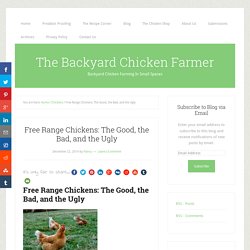
Before deciding what to do, it is best to look at the pros and cons of letting your chickens roam free. Several of our neighbors raise chickens, and most of them do so with coops surrounded by fully enclosed runs. In some cases, they don’t have the 2 acres to homestead with like we do, many times only one half-acre, so keeping free range chickens from straying to the neighbors is much more difficult. Then there are those backyard chicken farmers like our neighbors to the north of us, who breed show chickens and heirloom breeds to sell. The last thing they want is a bad boy from the wrong side of the tracks, mixing with their girls. Deciding to free range your flock. Deciding to Free Range Your Flock Often one of the first things a new chicken owner wants to do is let the flock out to free-range.
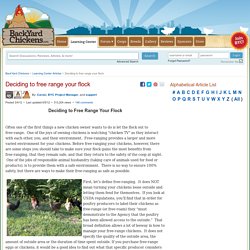
One of the joys of owning chickens is watching "chicken TV" as they interact with each other, you, and their environment. Free-ranging provides a larger and more varied environment for your chickens. Before free-ranging your chickens, however, there are some steps you should take to make sure your flock gains the most benefits from free-ranging, that they remain safe, and that they return to the safety of the coop at night.
One of the jobs of responsible animal husbandry (taking care of animals used for food or products), is to provide them with a safe environment. Beginners Guide to Keeping Ducks. Fodder FAQ's - Hostile Hare. What grain is best for Fodder?
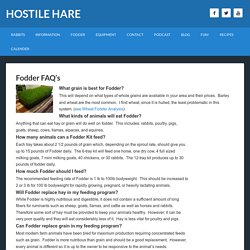
This will depend on what types of whole grains are available in your area and their prices. Barley and wheat are the most common. Murano Chicken Farm: Nobody says "mad as a wet duck" OR: why the deep litter method never works for me! It's quite simple really.
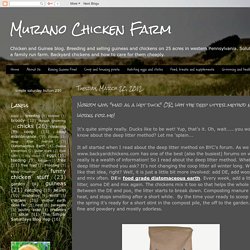
Ducks like to be wet! Yup, that's it. Oh, wait.....you wanted to know about the deep litter method? THE BENEFITS AND USES OF RABBIT MANURE. Anyone who comes to the rabbitry and my homestead will see our many gardens.
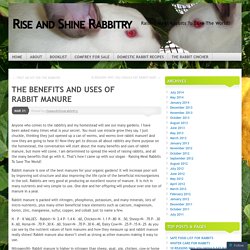
I have been asked many times what is your secret. RABBITS AND REDWORMS- Sustainability Above and Below! When raising rabbits if you have a few cages or a large rabbitry you can raise, grow, and harvest worms and compost under your rabbit cages or hutches. Raising worms under your hutches this will help control the smells and insects that can be a problem with the acculmated waste under the cages and hutches. The worms will reuse the rabbit manure and wasted feed from the hutches and turn it into a dark, nutrient-rich, finely-textured humus Raising rabbits and worms together works so well because the nutrients in rabbit droppings and the wasted rabbit food and hay contains the perfect mix as a food source and as a bedding for the worms. Raising Earthworms to Feed the Flock.
Note that I have decided to duplicate the article in the Composting section, The Boxwood Vermicomposting System, so that it appears here as well, offering the option of cultivating earthworms as high-protein feed for poultry. The original article, published in the April/May 2008 issue of Backyard Poultry Magazine, was titled “Poultry Feed from Worm Bins.” Regular visitors to this site know I am always looking for integrated patterns in which one element in the homestead, food-self-sufficiency enterprise supports and enables another; in which problems transform into benefits; and in which the homesteader finds unexpected synergies—that is, biological efficiencies that surpass in sophistication and beauty the crude “efficiencies” of machine and chemical agriculture.
Raising Chickens 2.0: No More Coop and Run! Benefits-of-sprouts-for-feed.pdf. Add Carbon: Deep Litter Method - Daddykirbs Farm. Do you want an easier way to help keep clean chicken runs? Add carbon. Clean. That really is a relative word. My runs are rarely ever “clean”, but adding carbon to the chicken runs helps neutralize the negative affects of the chicken and duck manure. This is commonly called the Deep Litter Method for managing chicken manure. Add Carbon For Chicken Playtime. Chicken Coop Bedding: Sand, the Litter Superstar. The material that covers the floor of a chicken coop is commonly referred to as “bedding,” which is more aptly termed “litter,” as chickens don’t sleep on the floor, they poop on it.
Litter’s primary functions are to absorb moisture from droppings and water spills, keep odors down and facilitate coop cleaning. The most commonly used litter options are: wood shavings, wood horse stall pellets, sand, hay and straw. The Deep Litter Method of Waste Management in Chicken Coops. Raising ducks or chickens? Ten reasons to choose ducks. How to: Raising Ducks in your urban farm or backyard. Updated March 27, 2015 We recently gave a presentation on raising ducks for backyard or small farm organic egg production. How to Homestead in a Travel Trailer: 8 Steps. Edit Article. Wood Burning: Dangerous to your Health. Find Out Healthier Solutions. Solar Power - Help Choosing an Off Grid Way of Life. No Regrets: 10 Key Things to Consider Before Moving to the Country.
The country lifestyle is not for everyone. Every day I commute into my job in the city I hear at least one fellow commuter complaining about the ferry service. Or about logging on the local mountain. Eating Off the Grid. 4 Best Methods for Off-the-Grid Food Production. Activist Post For most of us producing all of our own food is just a fantasy. It evokes visions of multiple acres of fertile land, long work days, and expensive machinery. However, none of these are necessary to achieve self-sufficient food production. There are many gardening techniques that can produce an abundance of food for you and your family without requiring a lot of space, money or equipment. How to become Water Self Sufficient for Survival Preparedness.
Rolling Stone: Portable Prefab Pod House Design. Inspired by gypsy wagons, rolling stones and mobile homes, this mobile living design functions on a great many levels. It is intended to be a self-sufficient housing unit, an open-air studio and even a stage as needed – a kind of hybrid of the best mobile building ideas of the 20th century.
Like a wagon, this capsule home by Nice Architects contains everything one would need to live, including self-contained energy, water and waste systems. Reflective recycled-can surface material blends the pod into its environment while reusing eco-friendly materials as cladding. Living Off the Grid: Free Yourself. U.S. Fault Lines GRAPHIC: Earthquake Hazard MAP. Water and Sewer Off Grid"
Wells.